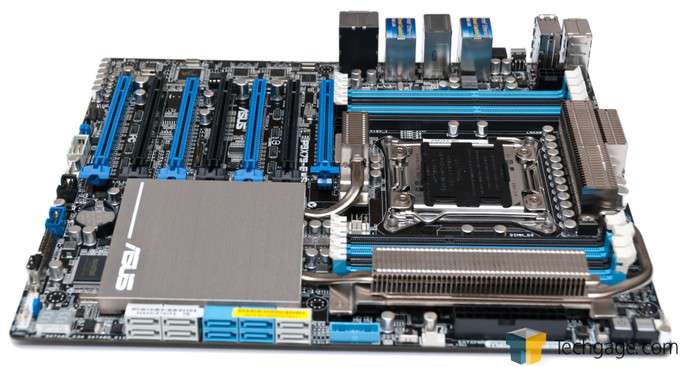- Qualcomm Launches Snapdragon 4 Gen 2 Mobile Platform
- AMD Launches Ryzen PRO 7000 Series Mobile & Desktop Platform
- Intel Launches Sleek Single-Slot Arc Pro A60 Workstation Graphics Card
- NVIDIA Announces Latest Ada Lovelace Additions: GeForce RTX 4060 Ti & RTX 4060
- Maxon Redshift With AMD Radeon GPU Rendering Support Now Available
ASUS P9X79-E WS Workstation Motherboard Review

If a workstation build is in the cards, or you’re looking to build the baddest multi-GPU gaming rig around, the X79 platform remains the one to consider. But what motherboard could possibly fill the “ultimate” void, one that’s able to handle a lot of stress, or for that matter, 7 graphics cards? Look no further than ASUS’ P9X79-E WS.
Page 6 – Performance Testing & Final Thoughts
From a performance perspective, we feel that motherboard benchmarking is useless. It’s the motherboard’s job to allow all of the installed hardware to operate at its full potential, so in theory, a $100 option shouldn’t be much (or any) slower than a $300 one. The differences in price instead comes down to the quality of the onboard components and other features.
So why do it at all? It’s because it’s important to make sure that the board we’re dealing with doesn’t lack in one particular area versus the rest. If board A performs 2% slower than board B in PCMark, for example, that’s of no concern to us – random benchmark variance is a fact of life. However, if one board consistently performs weaker than the rest, that’s worthy of note – it could suggest that weaker components have been used which do not allow the hardware to operate at its full potential.
But here’s where this particular article is a little different: We are not comparing ASUS’ P9X79-E WS to another X79 board, as it’s sure to be the last X79 board we take a look at (we feel it’s niche; Haswell is better-suited for most people).
So, to put something on this page, we’re comparing the Core i7-4960X at stock speeds against itself at overclocked speeds. In the EFI, we managed to hit a stable 4.5GHz (3.6GHz is stock) simply by adjusting the per-core value to 45, and setting the XMP profile. Certain voltages were increased, but they were increased by the board itself – not manually. This overclock is 100% stable, one we’re confident enough in that we have adopted it for use in our GPU test rig.
| Intel X79 Test System | |
| Processors | Intel Core i7-4960X – Six-Core @ Stock & 4.50GHz |
| Motherboard | ASUS P9X79-E WS |
| Memory | Stock: Kingston HyperX Beast 32GB (4x8GB) – DDR3-1333 9-9-9 OC: Kingston HyperX Beast 32GB (4x8GB) – DDR3-2133 11-12-11 |
| Graphics | NVIDIA GeForce GTX 660 2GB (GeForce 331.40) |
| Audio | Onboard |
| Storage | Kingston HyperX 240GB SSD |
| Power Supply | Cooler Master Silent Pro Hybrid 1300W |
| Chassis | Cooler Master Storm Trooper Full-Tower |
| Cooling | Thermaltake WATER3.0 Extreme Liquid Cooler |
| Displays | Dell P2210H 22″ 1920×1080 x 3 |
| Et cetera | Windows 7 Professional 64-bit |
System Performance
Because we’re taking just a quick look at performance here, I’m not going to go into detail about what each benchmark is, or how it works. For those interested in learning such details, I recommend hitting-up our Intel Core i7-4960X review.
With that said, the before and after:
| Stock vs. OC | i7-4960X @ Stock | i7-4960X @ 4.5GHz | |
| Adobe Lightroom 4.4 | 538 seconds | 456 seconds | |
| Adobe Premiere Pro CS5.5 | 761 seconds | 634 seconds | |
| Autodesk 3ds Max 2011 | 998 seconds | 820 seconds | |
| Cinebench R11.5 | 11.28 | 13.69 | |
| CyberLink MediaExpresso | 2149 seconds | 1690 seconds | |
| dBpoweramp R14 | 637 seconds | 536 seconds | |
| Euler3D | 8.271 Hz | 10.256 Hz | |
| Futuremark 3DMark | 4726 | 4778 | |
| HandBrake 0.99 | 657 seconds | 536 seconds | |
| POV-Ray | 2019 PPS | 2435 PPS | |
| SPECapc 3ds Max 2011 | 9.74 | 11.49 | |
| Results in ‘seconds’ = lower is better. | |||
When work needs to get done just a bit quicker, it’s clear that 4.5GHz is worth pursuing. Some of the differences here are stark, with just one test showing little improvement – and it’s a gaming one, so that’s not too much of a surprise.
On a side note, I’d like to mention that we tested the P9X79-E WS with a ridiculous RAM configuration of 8x8GB at DDR3-2133 speeds, and it was 100% stable through all testing. The max supported memory speed on the board is DDR3-2400, so given what we saw with 2133, we’d anticipate that would be stable in a 64GB configuration as well.
One thing to bear in mind is that at such high speeds, more stress is placed on the board. Due to weaknesses on the X79 platform, overclocking the RAM at all on this board will overclock the CPU as well, while also increasing some voltages. When we forced stock CPU settings with DDR3-2133 without adjusting some voltages, the result was an unstable board.
Final Thoughts
ASUS’ P9X79-E WS is a little difficult to conclude on, but it has nothing to do with the board or ASUS’ design decisions. Instead, it has everything to do with the fact that at this point, X79 isn’t in high demand, and quite simply, most people are fine to do with Z87. We went into good detail on the front page of this review to help you understand if X79 is the platform for you, so I won’t rehash everything said there, but I will reiterate a couple of points.
The P9X79-E WS is designed with one of X79’s best usage scenarios in mind: Workstation use. Whether you’re creating content or running scientific simulations, X79 can prove to be an absolute boon, thanks to its unparalleled memory bandwidth, and of course, six cores to make use of. For gaming, X79 is also a good choice, as long as we’re talking multi-GPU. 2-way for modest GPUs on Z87 won’t likely be a problem, but for 3-way and higher, or even 2 way with two enormous GPUs, those extra lanes might deliver a better experience overall.
That all aside – what about the actual subject at hand, ASUS’ P9X79-E WS? At $500, there’s no denying that it’s designed as a one-stop shop for those who need the “ultimate” X79 offering, and I feel that ASUS has once again delivered on its promises. While it sucks to lack some Z87 niceties like a plethora of native USB 3.0 and SATA 6Gbps ports, that is something outside of ASUS’ control. The company did however make up for it with additional chips on the board. One other nice perk: Dual Intel LANs.
When I look at this board, I picture 7 GPUs filling each one of those slots for the most dedicated Folder, or four massive GPUs to help drive a 3×1 configuration or perhaps even a 4K monitor. This is a board that’s designed to power the most beastly personal computer, and the fact that the CPU socket can also utilize Intel’s Xeon processors validate the fact that it’s also built for ultimate stability.
Another nice feature on this board worth mentioning is SSD Caching II. “Boring”, you say? Sure – SSD caching isn’t new, but on this WS board, things have been taken to the next level. Need a massive ultra-fast cache? Pair 2 or 3 SSDs up with a single mechanical drive. Or, 2 SSDs for 2 mechanical drives. Either of these configurations would give an enormous fast cache to work with, so it shouldn’t ever feel like there’s a mechanical drive at the root of it all.

Given it’s a WS-specific feature, we can’t not talk about Dr. Power, a solution that monitors PSU usage to make sure that your system isn’t reaching dangerous power-draw levels. If you do, Windows software that remains hidden until it’s needed will warn you. Given the fact that workstation boards tend to be filled to the brim with hard drives, graphics cards, capture cards or what-have-you, Dr. Power really is an excellent feature to see here – one that sounds simple, but is in fact a major feature (and one that feels odd to not write much about, but there’s not much to write about!).
Finally, I don’t often dabble in overclocking, but I was impressed with it here. 4.5GHz isn’t an extreme overclock by any stretch, but the fact that I was able to hit it with almost no effort at all surprised me – I was lucky to hit 4.2GHz on the i7-3960X with actual effort put in. I am confident that with some additional tweaking, even higher than 4.5GHz can be hit, but as I had plans to find the perfect overclock for use in our GPU test rig, I decided to stop there.
For those who need a well-built, stable, feature-rich and serious X79 motherboard, ASUS’ P9X79-E WS is without question worth picking up.

ASUS P9X79-E WS
Support our efforts! With ad revenue at an all-time low for written websites, we're relying more than ever on reader support to help us continue putting so much effort into this type of content. You can support us by becoming a Patron, or by using our Amazon shopping affiliate links listed through our articles. Thanks for your support!






